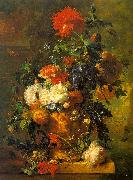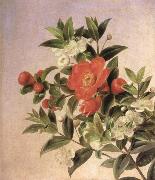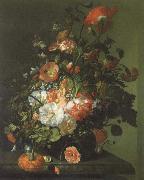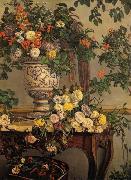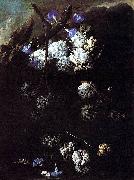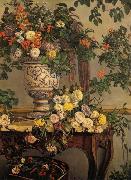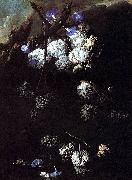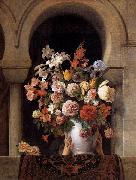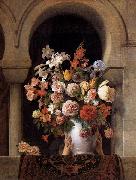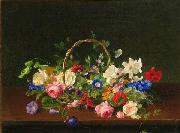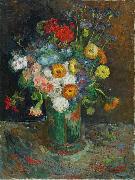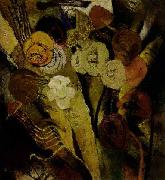Wholesale Oil Painting No Minimum |
|||||||||||
|
|
|||||||||||

|
|||||||||||
|
|
|
||||||||
Jan van Huysum1682-1749 Dutch Jan Van Huysum Galleries He was the brother of Jacob van Huysum, and the son of Justus van Huysum, who is said to have been expeditious in decorating doorways, screens and vases. A picture by Justus is preserved in the gallery of Brunswick, representing "Orpheus and the Beasts in a wooded landscape", and here we have some explanation of his son's fondness for landscapes of a conventional and Arcadian kind; for Jan van Huysum, though skilled as a painter of still life, believed himself to possess the genius of a landscape painter. Half his pictures in public galleries are landscapes, views of imaginary lakes and harbours with impossible ruins and classic edifices, and woods of tall and motionless trees-the whole very glossy and smooth, and entirely lifeless. The earliest dated work of this kind is that of 1717, in the Louvre, a grove with maidens culling flowers near a tomb, ruins of a portico, and a distant palace on the shores of a lake bounded by mountains. Some of the finest of van Huysum's fruit and flower pieces have been in English private collections: those of 1723 in the earl of Ellesmere's gallery, others of 1730-1732 in the collections of Hope and Ashburton. One of the best examples is now in the National Gallery, London (1736-1737). No public museum has finer and more numerous specimens than the Louvre, which boasts of four landscapes and six panels with still life; then come Berlin and Amsterdam with four fruit and flower pieces; then St Petersburg, Munich, Hanover, Dresden, the Hague, Brunswick, Vienna, Carlsruhe, Boston and Copenhagen. |
||||||||
|
|
||||||||
Flowers
Flowers Painting ID:: 2218 |
1722
The Hermitage, St.Petersburg 1722 The Hermitage, St.Petersburg |
|||||||
|
|
||||||||
Jensen JohanDanish 1800-1856 |
||||||||
|
|
||||||||
|
|
flowers
flowers Painting ID:: 56209 |
mk247
1835,oil on canvas,7x6 in,19x17 cm,hamburger,kunsthalle,hamburg,germany mk247 1835,oil on canvas,7x6 in,19x17 cm,hamburger,kunsthalle,hamburg,germany |
||||||
|
|
||||||||
|
|
||||||||
|
|
flowers
flowers Painting ID:: 56883 |
mk250 year of the 18th century. Oil painting on cloth, about 76 x 61 cm. Toledo Museum of Art. mk250 year of the 18th century. Oil painting on cloth, about 76 x 61 cm. Toledo Museum of Art. |
||||||
|
|
||||||||
Frederic Bazilleb.Dec. 6, 1841, Montpellier, France d.Nov. 28, 1870, Beaune-la-Rolande French Frederic Bazille Galleries was a French Impressionist painter best known for his depiction of figures. Born in Montpellier, Herault, Languedoc-Roussillon, into a middle-class Protestant family, Bazille became interested in painting after seeing some works of Eugene Delacroix. His family agreed to let him study painting, but only if he also studied medicine. Bazille began studying medicine in 1859. He moved to Paris in 1862 to continue his studies. There he met Pierre-Auguste Renoir, was drawn to Impressionist painting, and began taking classes in Charles Gleyres studio. After failing his medical exam in 1864, he began painting full-time. His close friends included Claude Monet, Alfred Sisley, and Édouard Manet. Born to a wealthy family, Bazille helped support some of these artists by giving them space in his studio and materials to use. Bazille was just twenty-three years old when he painted several famous works, including The Pink Dress. His best known painting is Family Reunion (1867?C1868). |
||||||||
|
|
||||||||
|
|
Flowers
Flowers Painting ID:: 73582 |
Oil painting reproduction of FrXdXric Bazille.
cjr Oil painting reproduction of FrXdXric Bazille. cjr |
||||||
|
|
||||||||
|
|
||||||||
|
|
Flowers
Flowers Painting ID:: 74959 |
c. 1680
Oil on canvas
cjr c. 1680 Oil on canvas cjr |
||||||
|
|
||||||||
Frederic Bazilleb.Dec. 6, 1841, Montpellier, France d.Nov. 28, 1870, Beaune-la-Rolande French Frederic Bazille Galleries was a French Impressionist painter best known for his depiction of figures. Born in Montpellier, Herault, Languedoc-Roussillon, into a middle-class Protestant family, Bazille became interested in painting after seeing some works of Eugene Delacroix. His family agreed to let him study painting, but only if he also studied medicine. Bazille began studying medicine in 1859. He moved to Paris in 1862 to continue his studies. There he met Pierre-Auguste Renoir, was drawn to Impressionist painting, and began taking classes in Charles Gleyres studio. After failing his medical exam in 1864, he began painting full-time. His close friends included Claude Monet, Alfred Sisley, and Édouard Manet. Born to a wealthy family, Bazille helped support some of these artists by giving them space in his studio and materials to use. Bazille was just twenty-three years old when he painted several famous works, including The Pink Dress. His best known painting is Family Reunion (1867?C1868). |
||||||||
|
|
||||||||
|
|
Flowers
Flowers Painting ID:: 75205 |
English: Oil painting reproduction of Frederic Bazille.
cyf English: Oil painting reproduction of Frederic Bazille. cyf |
||||||
|
|
||||||||
|
|
||||||||
|
|
Flowers
Flowers Painting ID:: 76547 |
Date c. 1680
Medium Oil on canvas
Dimensions ? ?? cm
cyf Date c. 1680 Medium Oil on canvas Dimensions ? ?? cm cyf |
||||||
|
|
||||||||
Francesco Hayez1791-1882 Italian Francesco Hayez Galleries Hayez came from a relatively poor family from Venice. His father was of French origin while his mother, Chiara Torcella, was from Murano. The child Francesco, youngest of five sons, was brought up by his mother sister, who had married Giovanni Binasco, a well-off shipowner and collector of art. From childhood he showed a predisposition for drawing, so his uncle apprenticed him to an art restorer. Later he became a student of the painter Francisco Magiotto with whom he continued his studies for three years. He was admitted to the painting course of the New Academy of Fine Arts in 1806, where he studied under Teodoro Matteini. In 1809 he won a competition from the Academy of Venice for one year of study at the Accademia di San Luca in Rome. He remained in Rome until 1814, then moved to Naples where he was commissioned by Joachim Murat to paint a major work depicting Ulysses at the court of Alcinous. In the mid 1830s he attended the Salotto Maffei salon in Milan, hosted by Clara Maffei (whose portrait Hayez painted for her husband), and he was still in Milan in 1850 when he was appointed director of the Academy of Brera there. Assessment of the career of Hayez is complicated by the fact that he often did not sign or date his works. Often the date indicated from the evidence is that at which the work was acquired or sold, not of its creation. Moreover he often painted the same compositions several times with minimal variations, or even with no variation. His early works show the influence of Ingres and the Nazarene movement. His later work participates in the Classical revival. |
||||||||
|
|
||||||||
|
|
Flowers
Flowers Painting ID:: 79159 |
1st half of 19th century
Oil on canvas
Width: 95 cm (37.4 in). Height: 124 cm (48.8 in).
cjr 1st half of 19th century Oil on canvas Width: 95 cm (37.4 in). Height: 124 cm (48.8 in). cjr |
||||||
|
|
||||||||
Francesco Hayez1791-1882 Italian Francesco Hayez Galleries Hayez came from a relatively poor family from Venice. His father was of French origin while his mother, Chiara Torcella, was from Murano. The child Francesco, youngest of five sons, was brought up by his mother sister, who had married Giovanni Binasco, a well-off shipowner and collector of art. From childhood he showed a predisposition for drawing, so his uncle apprenticed him to an art restorer. Later he became a student of the painter Francisco Magiotto with whom he continued his studies for three years. He was admitted to the painting course of the New Academy of Fine Arts in 1806, where he studied under Teodoro Matteini. In 1809 he won a competition from the Academy of Venice for one year of study at the Accademia di San Luca in Rome. He remained in Rome until 1814, then moved to Naples where he was commissioned by Joachim Murat to paint a major work depicting Ulysses at the court of Alcinous. In the mid 1830s he attended the Salotto Maffei salon in Milan, hosted by Clara Maffei (whose portrait Hayez painted for her husband), and he was still in Milan in 1850 when he was appointed director of the Academy of Brera there. Assessment of the career of Hayez is complicated by the fact that he often did not sign or date his works. Often the date indicated from the evidence is that at which the work was acquired or sold, not of its creation. Moreover he often painted the same compositions several times with minimal variations, or even with no variation. His early works show the influence of Ingres and the Nazarene movement. His later work participates in the Classical revival. |
||||||||
|
|
||||||||
|
|
Flowers
Flowers Painting ID:: 82261 |
Oil on canvas
Dimensions Height: 124 cm (48.8 in). Width: 95 cm (37.4 in).
cyf Oil on canvas Dimensions Height: 124 cm (48.8 in). Width: 95 cm (37.4 in). cyf |
||||||
|
|
||||||||
Claude MonetFrench Impressionist Painter, 1840-1926 Claude Oscar Monet (14 November 1840 C 5 December 1926) was a founder of French impressionist painting, and the most consistent and prolific practitioner of the movement's philosophy of expressing one's perceptions before nature, especially as applied to plein-air landscape painting. The term Impressionism is derived from the title of his painting. Claude Monet was born on 14 November 1840 on the fifth floor of 45 rue Laffitte, in the ninth arrondissement of Paris . He was the second son of Claude-Adolphe and Louise-Justine Aubree Monet, both of them second-generation Parisians. On 20 May 1841, he was baptised into the local church parish, Notre-Dame-de-Lorette as Oscar-Claude. In 1845, his family moved to Le Havre in Normandy. His father wanted him to go into the family grocery store business, but Claude Monet wanted to become an artist. His mother was a singer. On the first of April 1851, Monet entered the Le Havre secondary school of the arts. He first became known locally for his charcoal caricatures, which he would sell for ten to twenty francs. Monet also undertook his first drawing lessons from Jacques-François Ochard, a former student of Jacques-Louis David. On the beaches of Normandy in about 1856/1857 he met fellow artist Eugene Boudin who became his mentor and taught him to use oil paints. Boudin taught Monet "en plein air" (outdoor) techniques for painting. On 28 January 1857 his mother died. He was 16 years old when he left school, and went to live with his widowed childless aunt, Marie-Jeanne Lecadre. After several difficult months following the death of Camille on 5 September 1879, a grief-stricken Monet (resolving never to be mired in poverty again) began in earnest to create some of his best paintings of the 19th century. During the early 1880s Monet painted several groups of landscapes and seascapes in what he considered to be campaigns to document the French countryside. His extensive campaigns evolved into his series' paintings. Camille Monet had become ill with tuberculosis in 1876. Pregnant with her second child she gave birth to Michel Monet in March 1878. In 1878 the Monets temporarily moved into the home of Ernest Hosched, (1837-1891), a wealthy department store owner and patron of the arts. Both families then shared a house in Vetheuil during the summer. After her husband (Ernest Hoschede) became bankrupt, and left in 1878 for Belgium, in September 1879, and while Monet continued to live in the house in Vetheuil; Alice Hosched helped Monet to raise his two sons, Jean and Michel, by taking them to Paris to live alongside her own six children. They were Blanche, Germaine, Suzanne, Marthe, Jean-Pierre, and Jacques. In the spring of 1880 Alice Hosched and all the children left Paris and rejoined Monet still living in the house in Vetheuil. In 1881 all of them moved to Poissy which Monet hated. From the doorway of the little train between Vernon and Gasny he discovered Giverny. In April 1883 they moved to Vernon, then to a house in Giverny, Eure, in Upper Normandy, where he planted a large garden where he painted for much of the rest of his life. Following the death of her estranged husband, Alice Hosched married Claude Monet in 1892. |
||||||||
|
|
||||||||
|
|
Flowers
Flowers Painting ID:: 93361 |
1860 - 1912
Medium oil on panel
Dimensions 91 x 48 cm (35.8 x 18.9 in)
cjr 1860 - 1912 Medium oil on panel Dimensions 91 x 48 cm (35.8 x 18.9 in) cjr |
||||||
|
|
||||||||
Horace Aumontpainted Flowers in 1860 |
||||||||
|
|
||||||||
|
|
Flowers
Flowers Painting ID:: 93721 |
circa 1860(1860)
Medium oil on canvas
Dimensions 49.5 x 65 cm (19.5 x 25.6 in)
cjr circa 1860(1860) Medium oil on canvas Dimensions 49.5 x 65 cm (19.5 x 25.6 in) cjr |
||||||
|
|
||||||||
Zygmunt Waliszewski(1897-1936) was a Polish painter, a member of the Kapist movement. Waliszewski was born in Saint Petersburg to the Polish family of an engineer. In 1907 his parents moved to Tbilisi where Waliszewski spent his childhood. In Tbilisi began his studies at a prestigious art school. In 1908 he had his first exhibition and participated in the life of artistic avant-garde. During World War I he fought with the Russian army, returning to Tbilisi in 1917. He visited Moscow several times and became inspired by the Russian Futurists. He, later, became a member of a Futurist group. In the early 1920s, he departed for Poland, and settled in Krakew. Between 1921 and 1924 he studied at Academy of Fine Arts in Krakew in the studios of Wojciech Weiss and Jezef Pankiewicz. In 1924 he went to Paris with his avante-garde group and continued his studies in painting there under the guidance of Pankiewicz. He was a participant in the Capists' plein-air painting workshops in Cagnes, Valence, Cap Martin, and Avignon. At the Louvre, he painted copies and travesties of the works of old masters like Titian, Veronese, Velezquez, Vermeer, Goya, and Delacroix. He was also fascinated by the art of Cezanne, van Gogh, and Matisse. In 1931 he returned to Poland, residing in Warsaw, Krzeszowice, and Krakew. During this time Waliszewski designed scenery and posters, created book illustrations, drew and painted caricatures and grotesque scenes. In Krakew he befriended the Polish Formists. Waliszewski painted primarily portraits and figural compositions and landscapes of the rural countryside. He died suddenly in 1936. |
||||||||
|
|
||||||||
|
|
Flowers
Flowers Painting ID:: 95920 |
Date 1929(1929)
Medium oil on cardboard
Dimensions 61.5 x 50.5 cm (24.2 x 19.9 in)
ttd Date 1929(1929) Medium oil on cardboard Dimensions 61.5 x 50.5 cm (24.2 x 19.9 in) ttd |
||||||
|
|
||||||||
Vincent Van GoghDutch Post-Impressionist Painter, 1853-1890 Vincent Willem van Gogh (30 March 1853 ?C 29 July 1890) was a Dutch Post-Impressionist artist. Some of his paintings are now among the world's best known, most popular and expensive works of art. Van Gogh spent his early adult life working for a firm of art dealers. After a brief spell as a teacher, he became a missionary worker in a very poor mining region. He did not embark upon a career as an artist until 1880. Initially, Van Gogh worked only with sombre colours, until he encountered Impressionism and Neo-Impressionism in Paris. He incorporated their brighter colours and style of painting into a uniquely recognizable style, which was fully developed during the time he spent at Arles, France. He produced more than 2,000 works, including around 900 paintings and 1,100 drawings and sketches, during the last ten years of his life. Most of his best-known works were produced in the final two years of his life, during which time he cut off part of his left ear following a breakdown in his friendship with Paul Gauguin. After this he suffered recurrent bouts of mental illness, which led to his suicide. The central figure in Van Gogh's life was his brother Theo, who continually and selflessly provided financial support. Their lifelong friendship is documented in numerous letters they exchanged from August 1872 onwards. Van Gogh is a pioneer of what came to be known as Expressionism. He had an enormous influence on 20th century art, especially on the Fauves and German Expressionists. |
||||||||
|
|
||||||||
|
|
Flowers
Flowers Painting ID:: 96922 |
1886(1886)
Medium oil on canvas
Dimensions 61 X 45.9 cm
cyf 1886(1886) Medium oil on canvas Dimensions 61 X 45.9 cm cyf |
||||||
|
|
||||||||
Frits Van den Berghe(3 April 1883 - 22 September 1939) was a Belgian expressionist painter. He was born at Ghent. Like his friends Constant Permeke and Gustave De Smet, he first adopted the late-impressionist style of Emile Claus, but converted to expressionism during World War I. |
||||||||
|
|
||||||||
|
|
Flowers
Flowers Painting ID:: 97139 |
oil on canvas, 72,5 x 66,5 cm.
Date 1930(1930)
cyf oil on canvas, 72,5 x 66,5 cm. Date 1930(1930) cyf |
||||||
|
|
||||||||
|
Frits Van den Berghe (3 April 1883 - 22 September 1939) was a Belgian expressionist painter. He was born at Ghent. Like his friends Constant Permeke and Gustave De Smet, he first adopted the late-impressionist style of Emile Claus, but converted to expressionism during World War I. Flowers oil on canvas, 72,5 x 66,5 cm. Date 1930(1930) cyf |
||||||||
|
|
||||||||
|
Prev Next
|
||||||||
|
|
||||||||
|
Related Paintings to Frits Van den Berghe :. |
||||||||
|
|
||||||||
|
CONTACT US |
